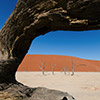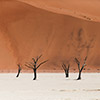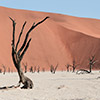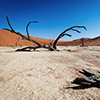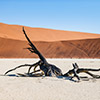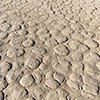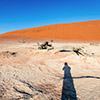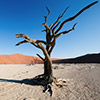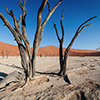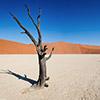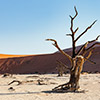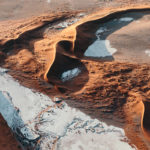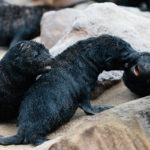The Trees of Deadvlei – Petrified Witnesses of Namib Desert
At the end of the funnel reaching into the big red dune giants of Namib Desert, that is Tsauchab River, is a place that could not be more unreal: the Deadvlei. The white clay pan is the stage of petrified acacia trees being up to 500 years old. Trees being so typical for the landscape of the Black Continent. They are witnesses of former water in the desert and even served as a backdrop of a film.
Unique place, unique desert
It is late afternoon and the sunset is not too far as I make my way from Sossusvlei to Deadvlei. Only now, in the approaching evening hours, the sun is not as relentless as it was at day time. When the desert reaches its temperature limit in the afternoon, the sand on the skin can cause blisters.
Vlei is Afrikaans and stands for salt pan, for a depression made of white clay-salt-rock. The Deadvlei illustrates the meaning of this word like no other. It is a place that could not be more surreal. As a visitor, you think you are in a picture of Salvador Dali. Unlike the Iranian desert with its Kalout rocks, Deadvlei is as flat as the ocean when there is no wind. Nevertheless, I find traces of former watercourses in the clay and salt rock, and they were still so small.
Despite the fading sun I park my jeep in the shade of a tree near Sossusvlei. There a few trees can live and survive from the few underground waters of Tsauchab River. Surprisingly, I am completely alone here at the end of the funnel reaching into the desert sand. Most of the visitors can be found in the early morning or in the morning.
Black, Red, Gold: Trees, Sand and Salt Rock
This morning I took a helicopter ride to see the dunes and the desert landscape at sunrise and from the air. With these impressions, the aerial desert view in my mind’s eye, one perceives the desert completely different. The bird’s eye view illustrates the uniqueness and fragility of the Deadvlei; the valley where the sun whipped all life out of the ancient acacia trees.
It takes a little time to walk from Sossuvlei to Deadvlei. And since you can spend two to three hours around and in Deadvlei, I prefer to wear long clothes and sturdy shoes. Because of the still potent sun…, and also because of the sand as its super-hot upper layers can leave bad blisters on the skin behind…
Not even a single cloud blurs the sky. Any steam was fried away by our central star. Buzzingly Cessna flying high above the desert as well as a helicopter pass by. Certainly, they see me as small black spot moving among firm black points (trees) only. And there they are. The black, petrified acacia trees of Deadvlei. Majestic. Mystical. Characterised by its morbid charm, framed by red sand and having dune giant “Big Daddy” in the background.
Alone at the End of the Desert
Now, as there’s nobody here, I can take pictures and try out different perspectives without running the risk of having a selfie idiot in the picture. People ruining places like Deadvlei by putting their puny earthly Instagram existence first, above nature and others, are a pest. What a blessing! There’s not even the merest sign of that pest noticeable far and wide. Only a Pied crow sits down not far from me and eyes me critically. Probably because I don’t jump about wildly posing with a selfie stick.
Around sunrise and sunset, Namib desert is most mystical and also most surprising. When animals like Oryx antelopes appear out of nowhere and the low sun bathes everything in warm light. But unfortunately, that is also the time to go back slowly, because of the closing national park gates. Missing that is something rangers don’t like to see… ;-) Deadvlei has a vibe, that also inspired the makers of Hollywood blockbuster The Cell with Jennifer Lopez.







